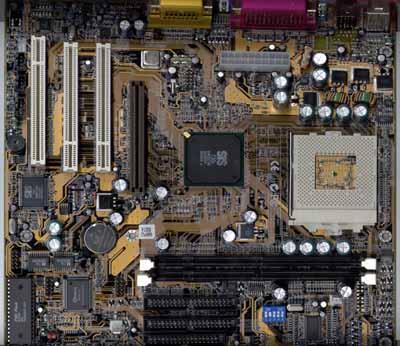Integrated Video Chipset Roundup - January 2001
by Matthew Witheiler on January 10, 2001 4:23 AM EST- Posted in
- Motherboards
Socket-A Solutions: SiS' 730S
We were pleasantly surprised when we recently had a chance to get our hands on SiS' integrated video solution for the Socket-A platform, the SiS 730S chipset. It was the first chipset of its kind to enter the Socket-A market, potentially brining the platform down to lower cost systems.
Despite exceptional performance for the price, AMD's Duron processor was having quite a hard time entering the value PC field. Unlike Intel's Celeron solution, AMD's Duron processor lacked one thing: an integrated motherboard to work with. Without having a low cost motherboard solution out there, the Duron processor was essentially eliminated from the large system manufacturer pool such as Gateway and Compaq. Since from the OEM's perspective, where price is the bottom line, it did not matter that the Duron outperformed Intel's Celeron processor clock for clock, all that mattered is that it cost significantly more to build a Duron computer since an additional video card had to be added to the package. SiS saw the opportunity to bring the Duron processor to the large scale value PC market and the product of this realization is the SiS 730S chipset.
The SiS 730S takes integration to a higher level then previously encountered, incorporating not only the graphic controller but also the south bridge. The SiS 730S uses the SiS 300 graphics core, a solution designed by SiS themselves. Similar to other integrated graphics controllers out there, the SiS 300 graphics core takes integrated performance one step further by incorporating hardware motion compensation and iDCT support. This helps to reduce CPU usage while playing DVD/MPEG2 streams which typically consume a large amount of processing power. More information about these two features can be found in our DVD Quality, Features, and Performance article.
The SiS 300 uses the unified memory architecture described in the "How it Works" section of this review, meaning that the graphics controller makes use of system memory for the frame buffer. Depending on the memory used, PC100 or PC133, the SiS will have a theoretical maximum memory bandwidth of 800MB/s (PC100) or 1.06GB/s (PC133). Once again, the video controller is sharing this bandwidth lots of other data that is normally traveling to and from the system memory, meaning that this maximum memory bandwidth number is never fully realized.
The integration of the south bridge in the north bridge chip is another method SiS took to reduce chipset cost. Not only are the traces between the north bridge and the south bridge eliminated, the board can be physically smaller as there no longer needs to be space for a second physical chip.
The SiS 730S also supports an external AGP 4X port, making upgrade possible. The system can operate with PC133 or PC100 SDRAM memory and offers no support for DDR. Other features include support for 6 USB ports as well as AC'97, integrated ethernet, and Modem Riser card support. One final unique feature of the SiS 730S platform is the fact that the northbridge has a dedicated 133MB/s path to the IDE channel, meaning that any bottlenecks that may arise when ATA/100 drives become mainstream should be solved.
For more information on the SiS 730S chipset, please see our full review of the chipset.
The SiS 730S Reference Board











0 Comments
View All Comments